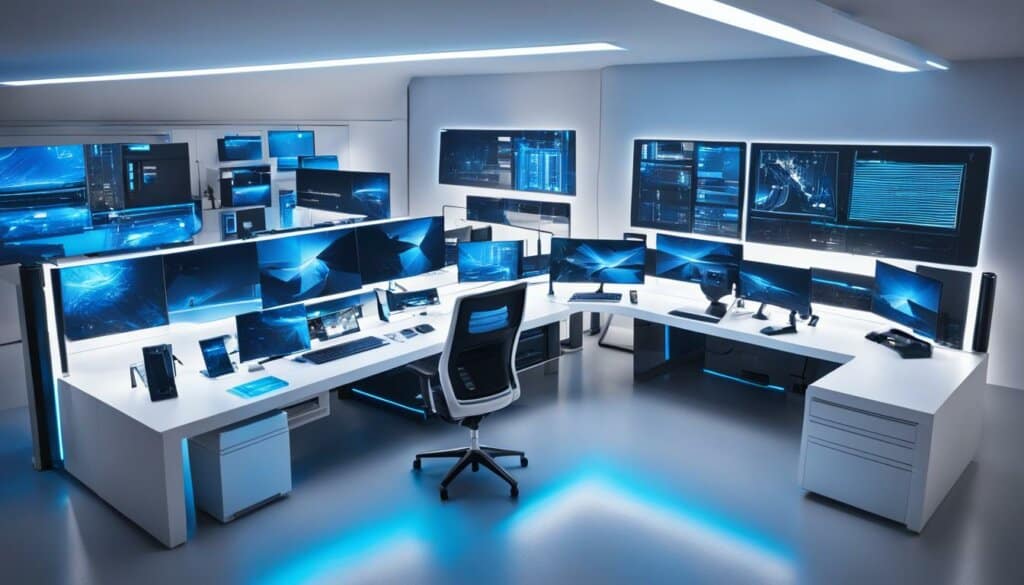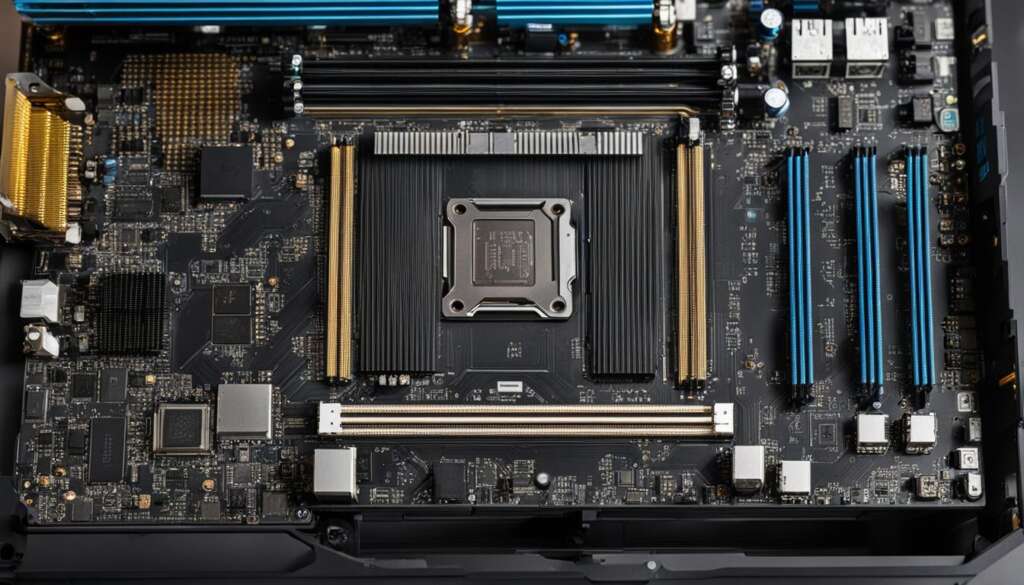Table of Contents
ChatGPT is a state-of-the-art conversational AI model that relies on powerful hardware to deliver fast and reliable AI-driven conversations. In this article, we will explore the hardware behind ChatGPT, including its requirements, system specifications, compatibility, and supported devices.
Understanding the hardware requirements of ChatGPT is essential for users looking to optimize their experience with this advanced conversational AI. By knowing the system specifications, you can ensure that your device meets the necessary criteria for using ChatGPT.
ChatGPT is designed to be compatible with a wide range of devices, enabling users to access its capabilities across various platforms. Whether you prefer using a desktop computer, laptop, tablet, or smartphone, ChatGPT can be seamlessly integrated into your preferred device.
By providing support for multiple devices, ChatGPT allows users to engage in dynamic and immersive conversations while enjoying a user-friendly interface. Its hardware compatibility ensures that users can access its powerful AI capabilities on the device of their choice.
The Two Phases of Machine Learning Model Development
Machine learning models like ChatGPT undergo two key phases: the training phase and the inference phase.
In the **training phase**, the model is exposed to large amounts of data and undergoes repetitive computations to learn patterns and make predictions. This phase requires **massive compute power** to handle the complex calculations involved in training the model.
The hardware used for training plays a crucial role in shaping the **model’s requirements**. To handle the immense computational workload, powerful GPUs like the Nvidia V100 are often used. These GPUs offer exceptional processing capabilities and parallel computing, making them ideal for training machine learning models.
On the other hand, in the **inference phase**, the trained model is deployed to handle user interactions and queries. The focus shifts to **low latency** and **high throughput** to provide quick and accurate responses. The hardware for inference needs to support real-time processing and efficiently handle user requests.
To ensure smooth and responsive interactions, systems like ChatGPT rely on a distributed network of servers. For example, Microsoft Azure servers are used to handle the inference process for ChatGPT. These servers are specifically optimized to deliver fast response times and handle simultaneous user interactions.
The table below summarizes the main differences between the training and inference phases in terms of hardware requirements:
| Training Phase | Inference Phase |
|---|---|
| Requires massive compute power | Focus on low latency and high throughput |
| Uses powerful GPUs (e.g., Nvidia V100) | Relies on distributed server networks |
| Handles large amounts of data and repetitive computations | Handles user interactions and queries |
To visualize the hardware requirements in the two phases, refer to the following image:
Understanding the differences between the training and inference phases of machine learning model development is crucial for optimizing hardware resources and delivering efficient AI-powered applications.
Hardware Used to Train ChatGPT
During the training of ChatGPT, Microsoft’s supercomputer utilized over 10,000 Nvidia V100 GPUs. These powerful GPUs, combined with Microsoft Azure infrastructure, enabled the training of GPT-3, the predecessor to ChatGPT. Although specific configuration details were not disclosed, the use of V100 GPUs was confirmed through scientific papers published by OpenAI. The use of this hardware showcases the significant compute power required for training large-scale language models.
To provide a more in-depth understanding of the hardware used to train ChatGPT, the following table highlights the key specifications of the Nvidia V100 GPUs:
| Specification | Description |
|---|---|
| GPU Architecture | Volta |
| CUDA Cores | 5,120 |
| Tensor Cores | 640 |
| Memory Capacity | 16 GB or 32 GB |
| Memory Bandwidth | 900 GB/s |
| Peak Performance | 7.5 TFLOPS (FP64), 15.0 TFLOPS (FP32), 120 TFLOPS (Tensor) |
The Nvidia V100 GPUs provide the computational power necessary for the training phase of ChatGPT. Their high memory capacity, impressive memory bandwidth, and extensive peak performance capabilities allow for efficient processing of the vast amounts of data required to train large-scale language models.
Hardware Used for ChatGPT Inference
During the inference process for ChatGPT, Microsoft Azure servers play a crucial role in handling user interactions and queries. To meet the demands of millions of active users simultaneously, a distributed network of servers is required, rather than relying on a single instance of inference with Nvidia DGX or HGX A100 hardware.
Scaling ChatGPT’s inference capabilities requires the power and efficiency of over 3,500 Nvidia A100 GPUs powered servers. These high-performance GPUs enable seamless and rapid processing of user interactions, ensuring smooth and reliable conversational experiences.
The cost of running and maintaining such a large-scale system can range from $500,000 to $1 million per day. However, the investment is necessary to provide ChatGPT’s inference capabilities at the level of performance and responsiveness expected by users.

Future Hardware Developments for AI
The AI hardware industry is constantly evolving to optimize architectures for AI workloads, driving advancements that pave the way for more powerful and efficient AI systems. Key players such as Nvidia and AMD are at the forefront of these developments, with their upcoming releases promising significant performance gains.
Nvidia Hopper Generation GPUs
Nvidia’s Hopper generation GPUs are highly anticipated in the AI community. These GPUs are expected to deliver breakthrough performance improvements and enhanced capabilities, making them ideal for AI workloads. With advancements in architecture and processing power, Hopper GPUs will enable the training of more complex and larger-scale AI models.
AMD CDNA3 Based MI300 GPUs
AMD is also making strides in AI hardware development with its CDNA3 based MI300 GPUs. Designed to meet the demanding requirements of AI workloads, these GPUs offer high-performance compute capabilities and improved energy efficiency. The MI300 GPUs are expected to provide competitive alternatives to Nvidia’s offerings, driving innovation and pushing the boundaries of AI hardware.
The competition between Nvidia and AMD is beneficial for the AI hardware landscape as it fuels advancements in technology and encourages both companies to push the limits of what is possible. As a result, AI researchers and developers can expect more powerful and efficient hardware solutions to unlock new possibilities in AI-driven applications.
| GPU | Key Features |
|---|---|
| Nvidia Hopper Generation GPUs | – Breakthrough performance improvements |
| – Enhanced capabilities for AI workloads | |
| AMD CDNA3 Based MI300 GPUs | – High-performance compute capabilities |
| – Improved energy efficiency |
These upcoming hardware developments signify a promising future for AI, enabling the development of more advanced and sophisticated AI models. Increased performance and efficiency will unlock new opportunities across various industries, including natural language processing, computer vision, and autonomous systems.
As the hardware industry continues to evolve, researchers and developers can expect a continuous stream of innovative solutions that will drive the next generation of AI applications.
Conclusion
The hardware behind ChatGPT plays a significant role in its development, from the training phase to the inference process. The use of Nvidia V100 GPUs and Microsoft’s supercomputer highlights the compute power required for training large-scale models.
Inference, on the other hand, relies on a distributed network of Microsoft Azure servers to meet user demand. These powerful servers ensure low latency and high throughput, enabling seamless conversations with ChatGPT.
As hardware for AI continues to advance, the future holds even more powerful and efficient architectures. Innovations like Nvidia’s Hopper generation GPUs and AMD’s CDNA3 based MI300 GPUs promise to revolutionize natural language processing and conversation AI. These advancements in hardware will enable the development of even more sophisticated AI models and drive further progress in the field of AI-driven conversations.
FAQ
What are the hardware requirements for running ChatGPT?
Running ChatGPT requires robust hardware, including Nvidia V100 GPUs for the training phase and Microsoft Azure servers for the inference phase. Specific configuration details may vary.
Is ChatGPT compatible with all devices?
ChatGPT can be accessed through various devices, as it runs on Microsoft Azure servers. Users can interact with ChatGPT through web browsers, mobile devices, and other compatible platforms.
What hardware does ChatGPT utilize during the training phase?
ChatGPT’s training phase utilizes over 10,000 Nvidia V100 GPUs. The high compute power of these GPUs, in combination with Microsoft Azure infrastructure, enables the training of large-scale language models.
What hardware is used for ChatGPT’s inference process?
ChatGPT’s inference process is carried out on Microsoft Azure servers. While a single Nvidia DGX or HGX A100 instance is sufficient for an individual inference instance, meeting the demand of millions of active users simultaneously requires a distributed network of servers. It is estimated that over 3,500 Nvidia A100 servers are utilized for ChatGPT’s current level of demand.
What are the future hardware developments for AI that may impact ChatGPT?
The AI hardware landscape is continuously evolving. Future developments, such as Nvidia’s Hopper generation GPUs and AMD’s CDNA3 based MI300 GPUs, promise enhanced AI performance gains. These advancements will contribute to the training of even more sophisticated AI models.













